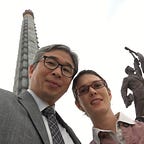Building Bonds that Lead to Trust
Sitting on our sofa adjacent to the Potong River in Pyongyang, our family studied U.S. History as part of our regular homeschool schedule. That day’s lesson was on “The End of the Cold War”. In a gesture of friendship, President Gorbachev’s administration of the Soviet Union was invited to visit Disney World in Florida. This began a thaw in the relationship between the U.S. and the U.S.S.R. Over the following years, President Reagan and President Gorbachev met multiple times, building a foundation of trust, and eventually putting an end to the Cold War.
At the time of this lesson, my children were approximately five, nine, and eleven years old. Despite their immaturity, they could relate directly to the story. We had been living in North Korea for over six years. After starting out in the northeast region, we had moved to the capital city of Pyongyang. All three of them were attending the Pyongyang Korean School for Foreigners as I supplemented their education in the afternoon through homeschool. We knew far too well the dynamics and tensions between communism and democracy, between socialism and capitalism. My children lived these tensions out in their daily lives through the contrasting education they received between home and school.
Through this particular history lesson, in their innocent minds the solution to this tension seemed simple. When I asked my children what they learned from the lesson, my son, who was nine at the time, said matter-of-factly, “We need to make our enemies our friends.” Then he followed up by asking, “Mom, why can’t North Korea and the United States become friends?”
With a big sigh, all I could said was, “It’s complicated. There was a war, and it’s not simple nor easy to just become friends after you have been at war.”
However, this history lesson was not just for my children. I had learned something new, too. Perhaps I had never been taught it, or perhaps I simply did not remember all that I learned in U.S. History class. Regardless, I internalized for the first time how the Cold War actually ended.
Typically, what we study in history focuses on the dramatic. Conflict, famine, depression, and war is what highlights our U.S. History textbooks. What would happen, though, if we focused on the conflict resolution instead of the conflict, itself? Perhaps we would glean from and find hidden treasures within these history lessons.
As with the tension between the Soviet Union and the United States, all too often we dehumanize the people we oppose. Objectivizing entire nations draws us away from the fact that these countries, too, consist of real, live people. But in order to deescalate tension, it is essential to take a humanistic approach. Reagan told journalists in Moscow during a visit in 1990, “President Gorbachev and I discovered a sort of a bond, a friendship between us, that we thought could become such a bond between all the people”.
President Reagan and President Gorbachev wrote back and forth letters over many years. Despite their stark differences, President Reagan was committed to resolving these differences. He wrote in a letter to President Gorbachev on March 11, 1985, “Our differences are many, and we will need to proceed in a way that takes both differences and common interests into account in seeking to resolve problems and build a new measure of trust and confidence.” President Reagan reaffirmed his commitment by declaring, “I believe our differences can and must be resolved through discussion and negotiation.”
What is lacking in the North Korea and U.S. relationship is this kind of willingness and commitment to build upon common interests instead of singling out differences. Indeed, history proves that a commitment to open communication and discussion transforms not only two people’s relationship but can also transform the relationship between two nations. In his autobiography, An American Life, Reagan wrote: “As I look back on them now, I realize those first letters marked the cautious beginning on both sides of what was to become the foundation of not only a better relationship between our countries but a friendship between two men.”
As Miroslav Volf explains, this was President Reagan and President Gorbachev’s journey of learning how to embrace the “other”. Our world’s conflicts are primarily problems revolving around the issue of identity and otherness. How we respond to and deal with others different from ourselves determines the outcome of our relationships. Will we have the courage to befriend those different from us or will we choose to escalate those differences into conflicts?
In a time when tensions and conflicts are on the rise, we have a critical choice to make regarding this issue of otherness. The core of this issue is distrust. We distrust those different from ourselves. President Reagan was often quoted as saying, “We don’t mistrust each other because we’re armed; we’re armed because we mistrust each other.”
Today we need to make the difficult and timely decision to start building bonds that lead to trust. On the Korean Peninsula, this means engaging in dialogue, discussion, and negotiations, again and again, year after year, time after time, until the day that trust can finally be built. Building trust is not simple. But the choice is simple. Trustworthy bonds lead to peace.
